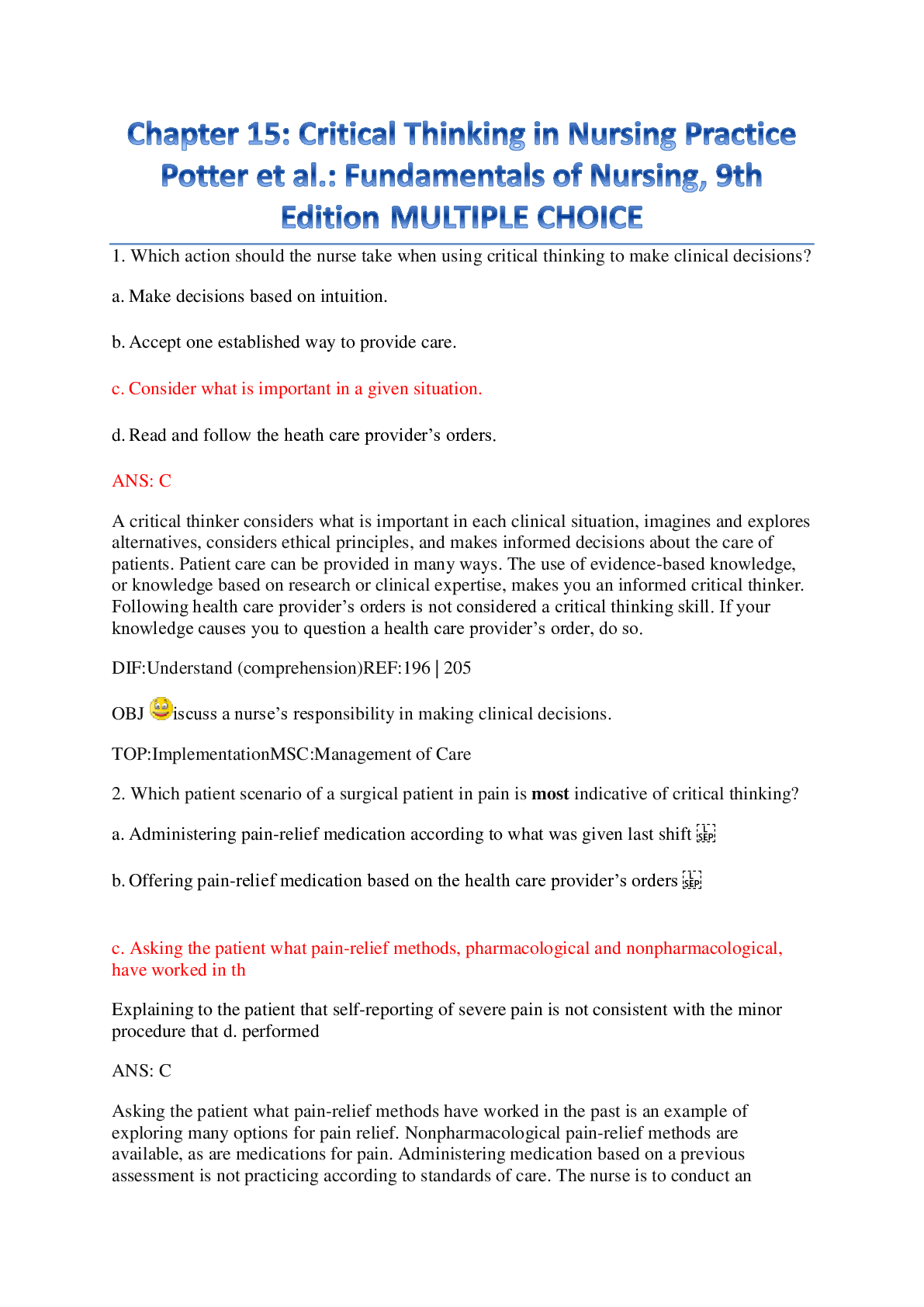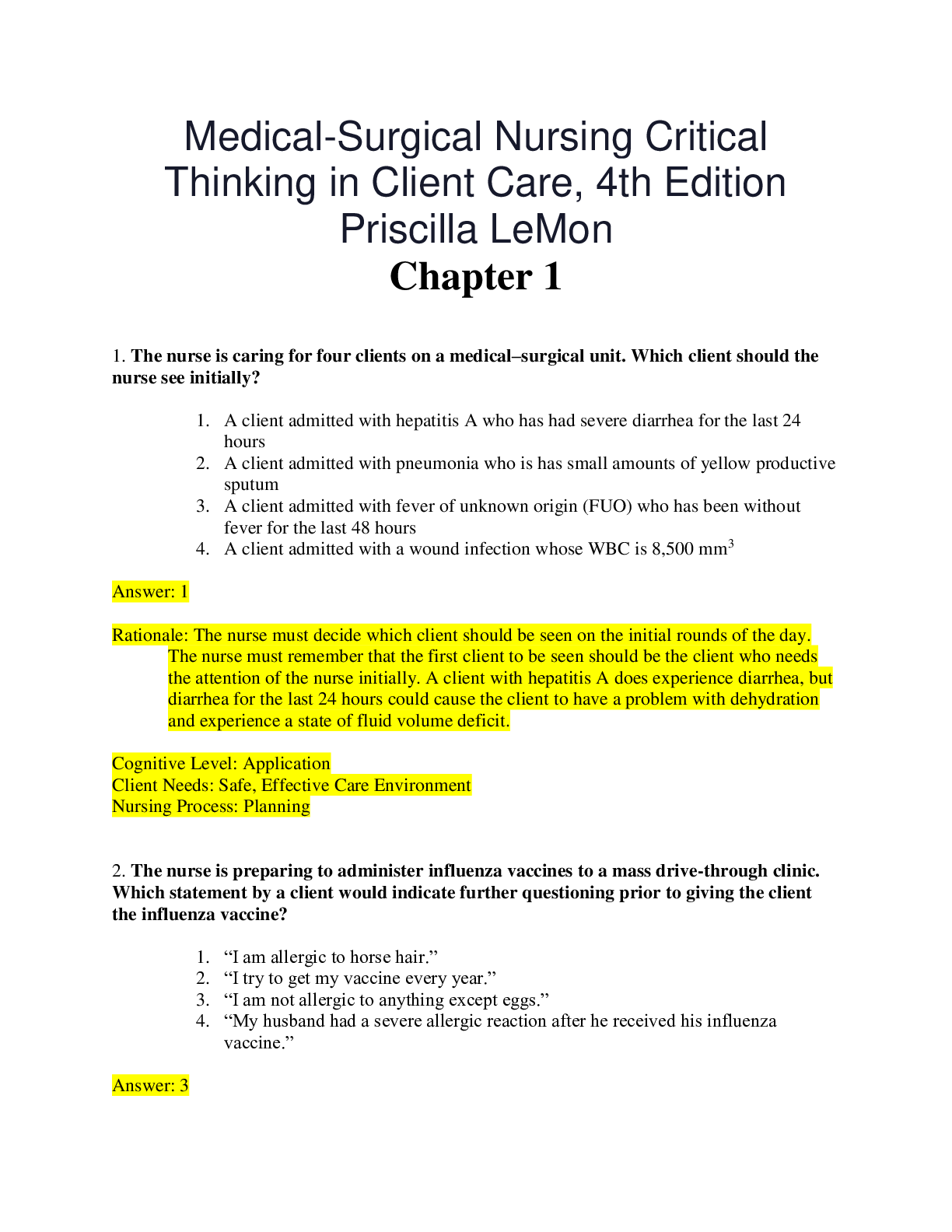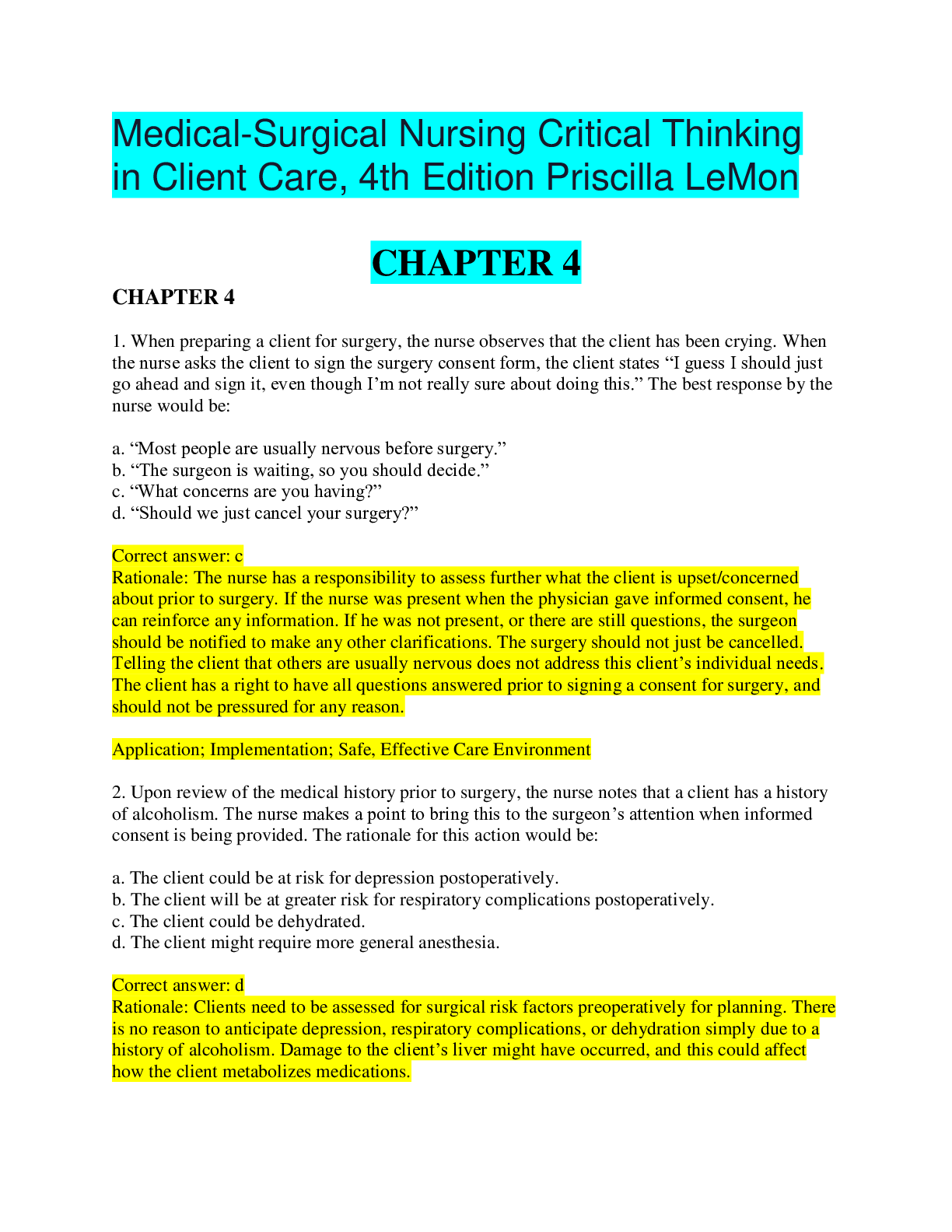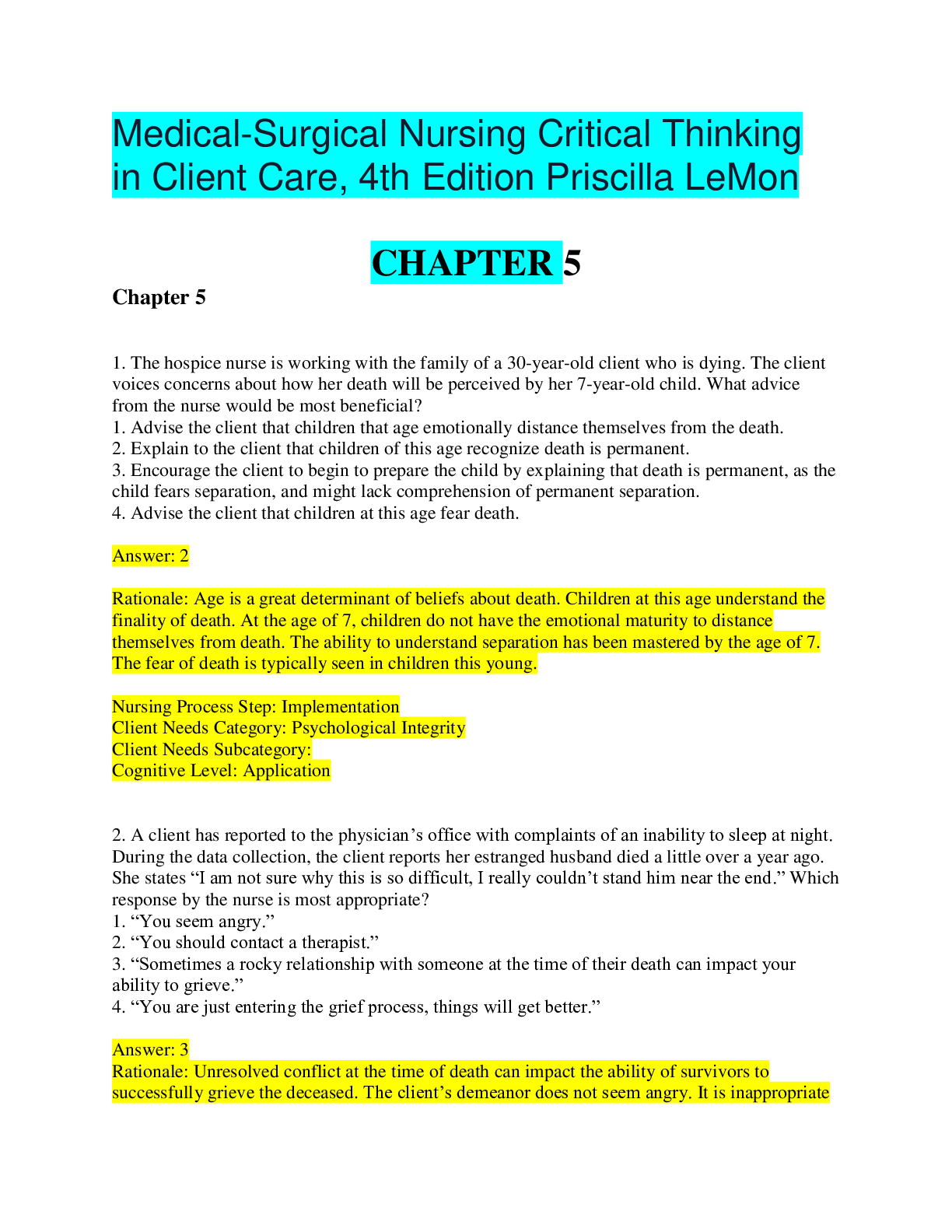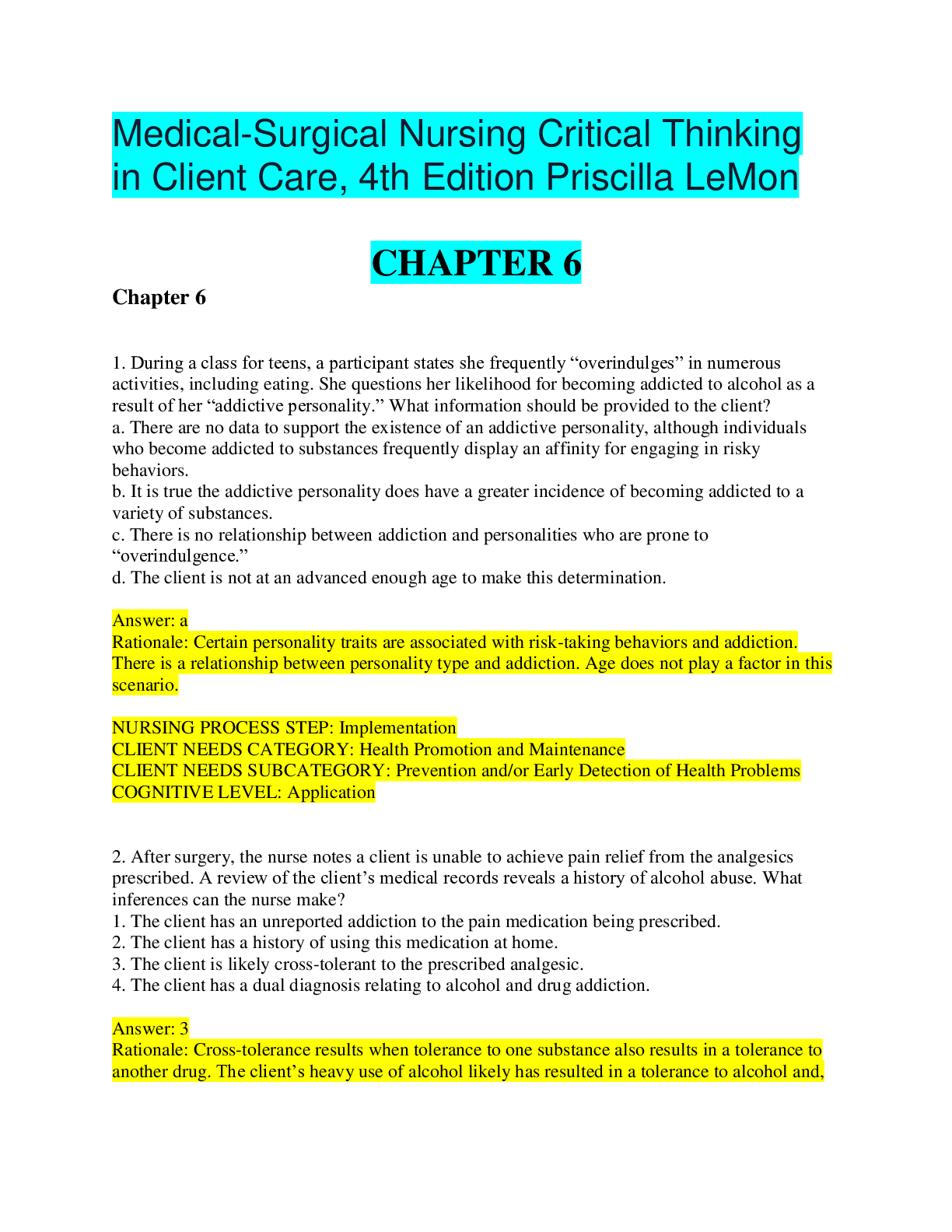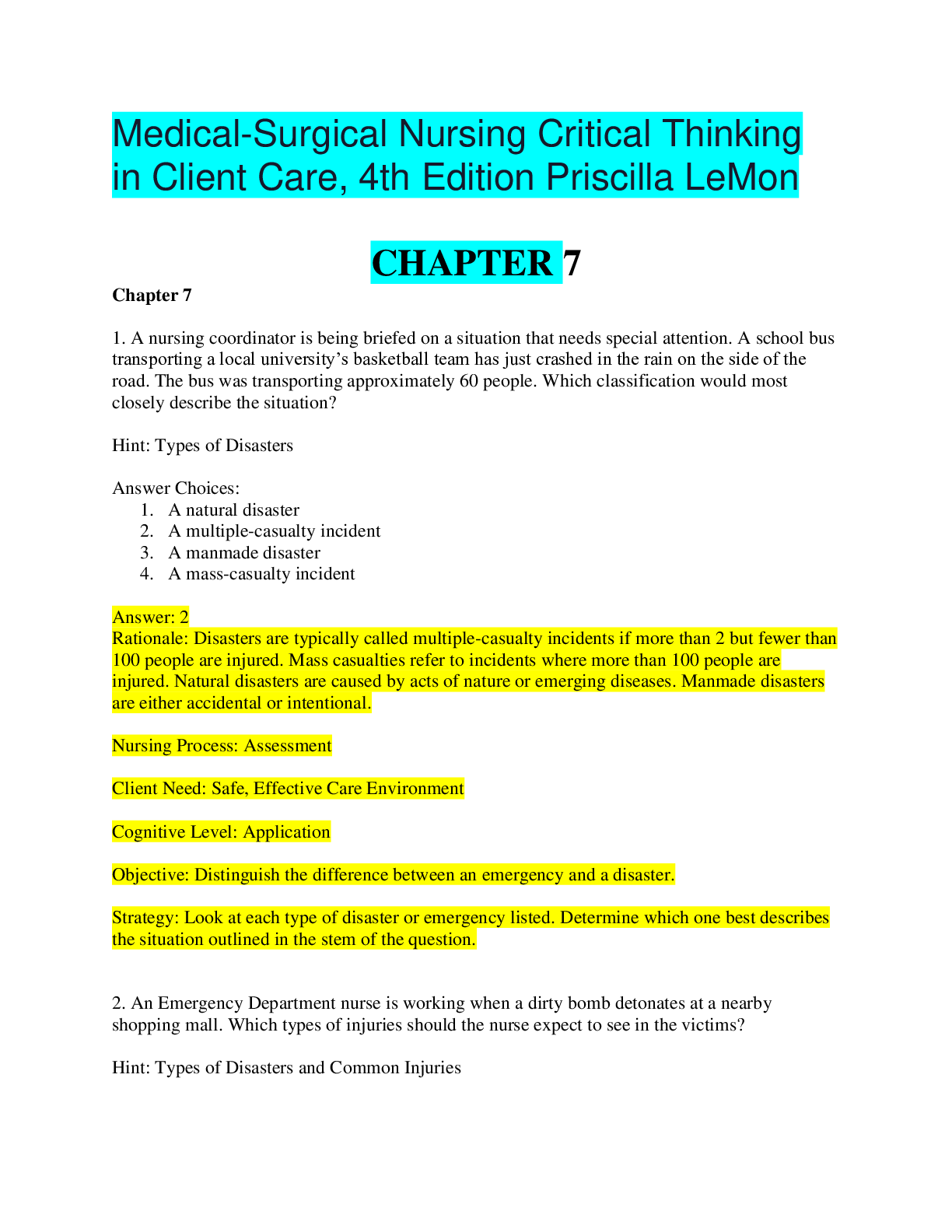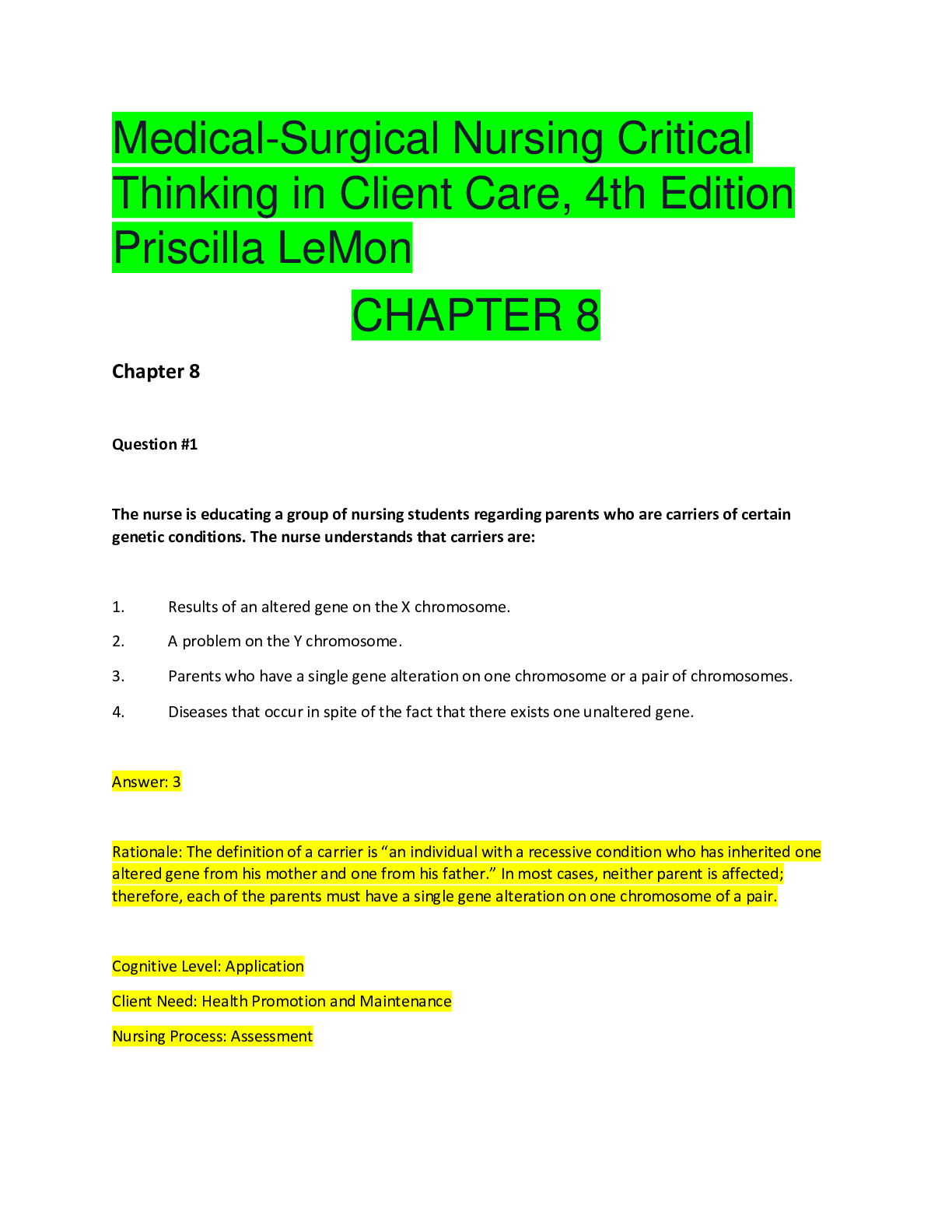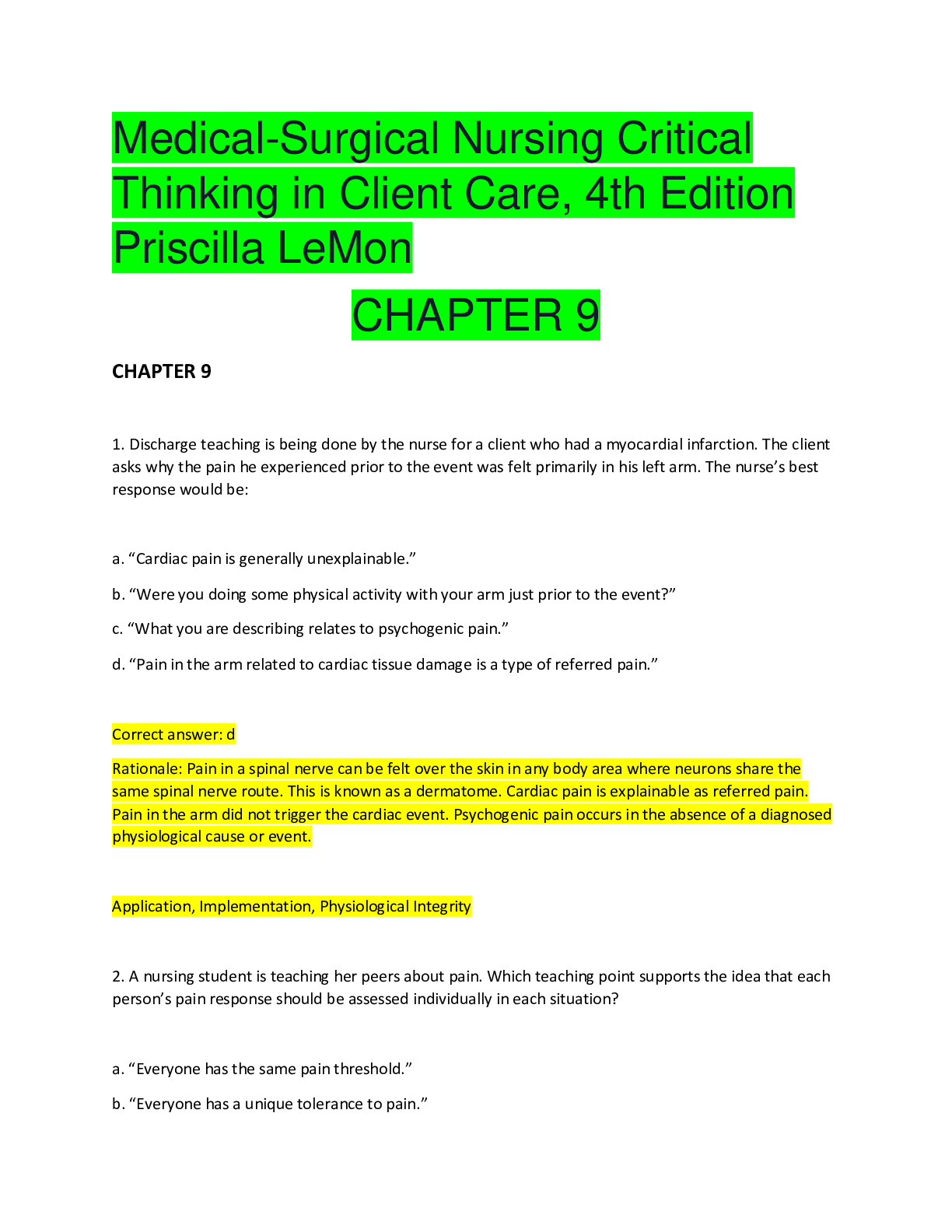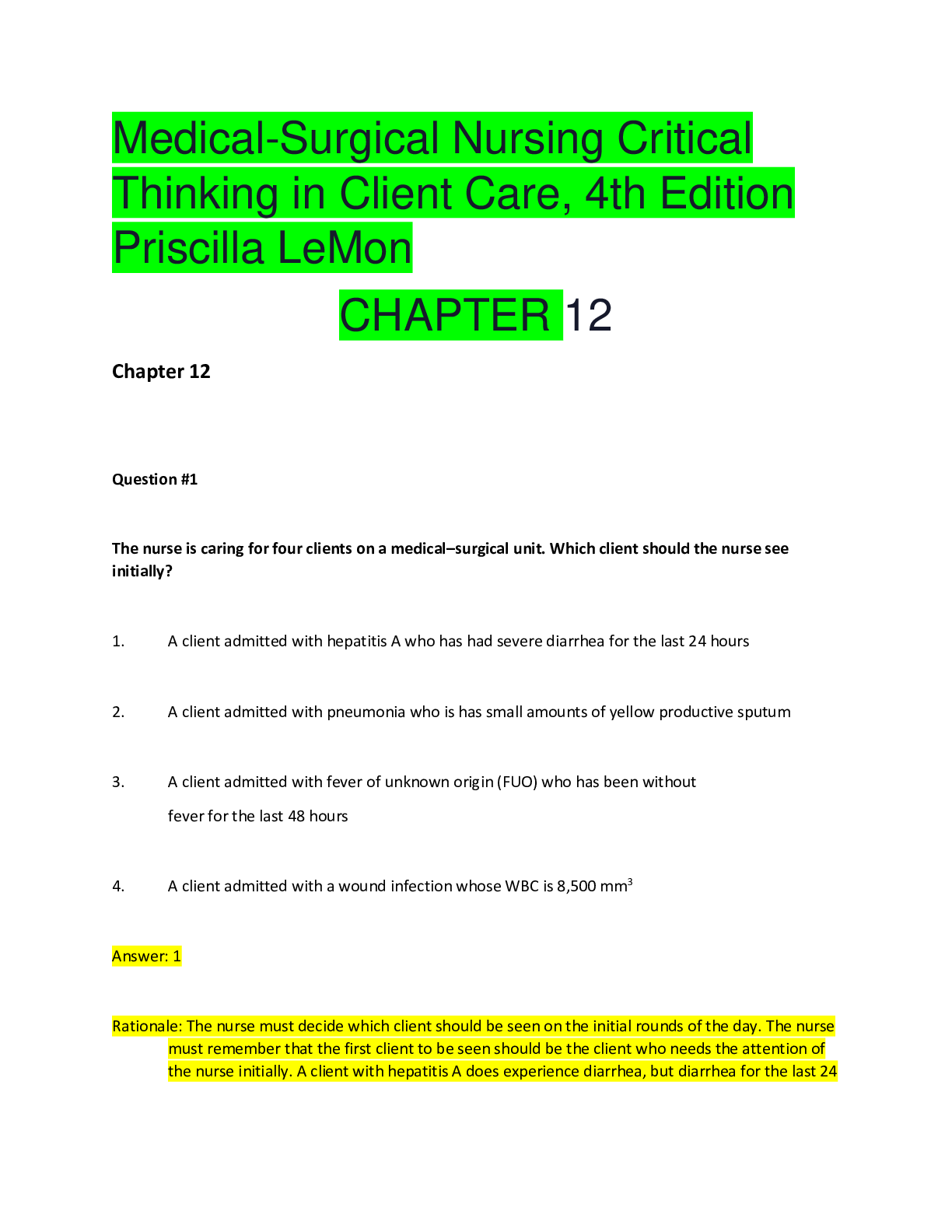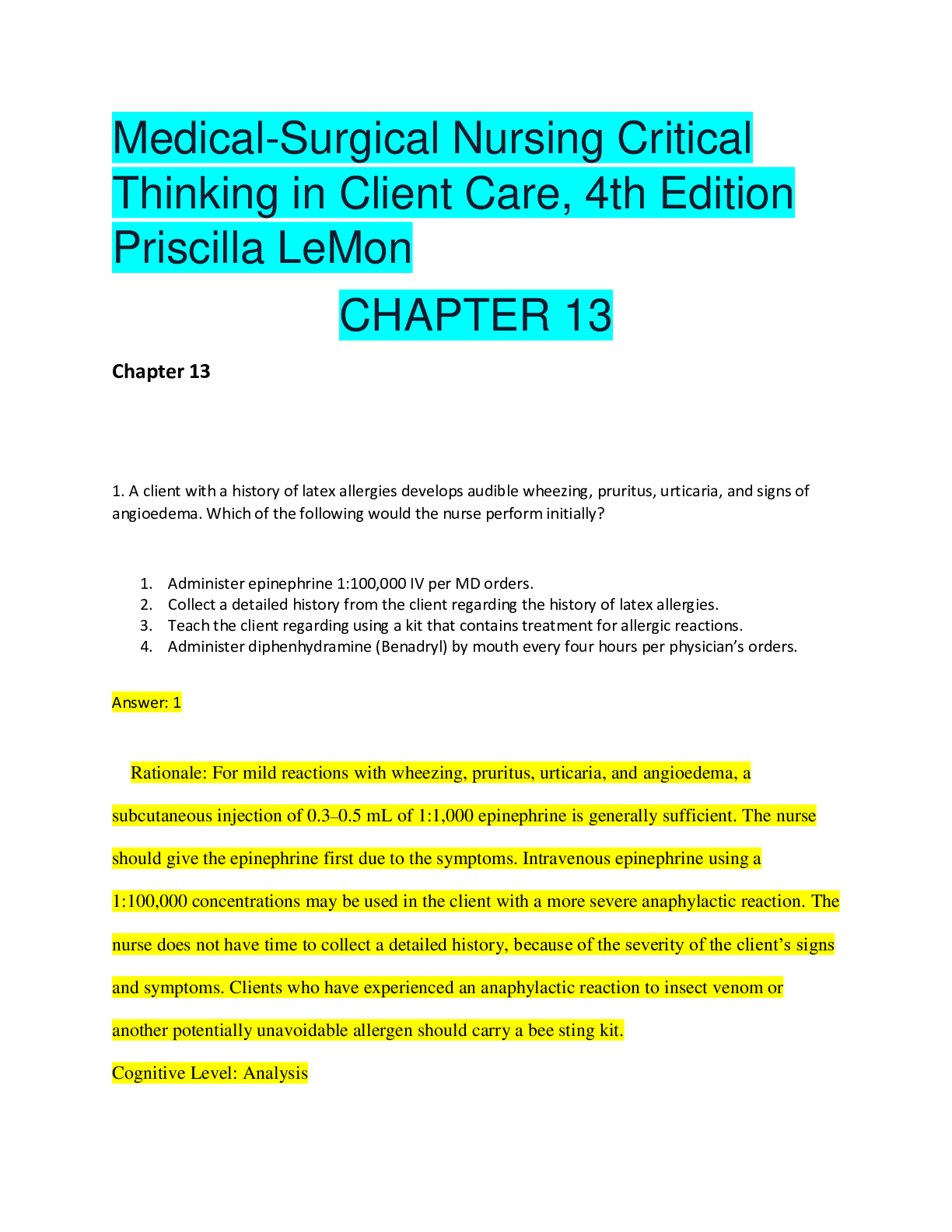Biology > QUESTIONS & ANSWERS > Fresno City College > BIOLOGY 102 > Medical-Surgical Nursing BIOLOGY 102. Critical Thinking in Clien (All)
Fresno City College > BIOLOGY 102 > Medical-Surgical Nursing BIOLOGY 102. Critical Thinking in Client Care, 4th Edition Priscilla LeMon CHAPTER 10 AND 11 (QUESTIONS, ANSWERS AND RATIONALE)
Document Content and Description Below
Medical-Surgical Nursing Critical Thinking in Client Care, 4th Edition Priscilla LeMon CHAPTER 10, 11 CHAPTER 10 1. What is a primary concern regarding fluid and electrolytes when caring for the... older adult who is intermittently confused? a. Risk of kidney damage b. Risk of stroke c. Risk of bleeding d. Risk of dehydration 2. A client is experiencing a multisystem fluid volume deficit. Symptoms present include tachycardia; pale, cool skin; and decreased urine output. These signs are most likely a direct result of: a. The body’s natural compensatory mechanisms. b. Pharmacological effects of a diuretic. c. Effects of rapidly infused intravenous fluids. d. Cardiac failure. 3. Clients experiencing a fluid volume deficit would most likely exhibit which of the following lab results? Select all that apply. a. Increased serum potassium b. Decreased serum sodium c. Increased hemoglobin d. Increased hematocrit 4. Which of the following tests would be indicated when a client who has a history of cardiovascular disease is receiving intravenous fluids? a. Cardiac catheterization b. Echocardiogram c. Fluid challenge d. Central venous pressure monitoring 5. A postoperative client has an indwelling urinary catheter in place. Which 24-hour urine output total volume would necessitate a primary healthcare provider to be notified? a. 1,000 milliliters b. 750 milliliters c. 1,200 milliliters d. 600 milliliters 6. A client is receiving intravenous fluids postoperatively following cardiac surgery. Nursing assessments should focus on which postoperative complication? a. Fluid volume deficit b. Fluid volume excess c. Liver failure d. Seizure activity 7. Clients with severe hyponatremia will need which specific intervention once the diagnosis is made? a. Infection precautions b. Seizure precautions c. High-risk fall precautions d. Neutropenic precautions 8. A client is admitted with hypokalemia. Which medication that the client has been prescribed might have contributed to this problem? a. Thiazide diuretic b. Narcotic c. Corticosteroid d. Muscle relaxer Chapter 11 1. A client is admitted to the ICU (intensive care unit) after sustaining multiple injuries. The physician has ordered for the client to receive a colloid solution. Which one of the following solutions would be appropriate for the nurse to infuse, based on the physician’s orders? 1. 9% saline 2. D5 ½ NS 3. 5% dextrose in water (D5W) 4. 25% albumin 2. A client is admitted to the medical intensive unit after being involved in a motor vehicle collision. During the nurse’s initial assessment, the client develops hypotension, and severe jugular distension with a tracheal deviation. What does the nurse suspect has occurred? 1. Hemorrhage 2. Tension pneumothorax 3. Compensatory shock 4. Hypovolemic shock 3. When assessing a client with a traumatic brain injury, the nurse assesses the client for which of the following signs and symptoms that would be consistent with brain death? Select all that apply. 1. Absence of gag or corneal reflex 2. Toxic metabolic disorders 3. Response to deep stimuli 4. Absence of oculovestibular reflex 5. Apnea with PaCO2 of 66 mm Hg 4. A client is admitted with a diagnosis of blunt trauma to the abdomen after a motor vehicle collision. What should be the initial action by the nurse when the client arrives in the Emergency Department (ED)? 1. Assess the client’s abdomen for any abnormalities. 2. Assess the client’s cervical spine for tenderness. 3. Assess the client for signs of neurological deficits. 4. Assess the client’s airway for patency. 5. Which of the following interventions would be essential for the nurse to assess first for a client admitted with severe facial injuries? 1. Assess the client’s level of consciousness. 2. Assess for signs of stridor, cough, or respiratory distress. 3. Assess the need for suctioning. 4. Assess the mouth for loose teeth or obvious problems with the mouth. 6. A client presents to the ED (Emergency Department) after sustaining a penetrating wound to the neck. The client is dyspneic and cyanotic, and has evidence of subcutaneous emphysema. What does the nurse expect the physician to do initially? 1. Intubate the client because of the severe wound. 2. Notify the next of kin regarding the client’s condition. 3. Order x-rays of the lumbar area to assess for fractures. 4. Administer a beta blocker to alleviate the sympathetic response. 7. A client is admitted with a traumatic injury to the spinal cord. He develops marked bradycardia, with a bounding pulse. The client becomes extremely restless, and the nurse notes that the client has developed oliguria as well. The nurse would suspect: 1. Anaphylactic shock. 2. Septic shock. 3. Hypovolemic shock. 4. Neurogenic shock. 8. A client presents to the trauma center after sustaining multiple injuries. The client experienced severe blood loss prior to arriving at the trauma center. The physician has ordered for the client to receive blood immediately. The nurse understands that since there is not sufficient time for type and crossmatch, the client will therefore receive: 1. O group blood. 2. A group blood. 3. B group blood. 4. AB group blood. 9. A client who was a victim of rape six months ago presents to an outpatient clinic for the treatment of post-traumatic stress disorder (PTSD). Which data collected during the client’s assessment would indicate a manifestation associated with PTSD? 1. The client denied anger or shock. 2. The client discussed severe nightmares related to the traumatic event. 3. The client denied the need for drug or alcohol counseling. 4. The client stated that her family is very supportive. 10. The nurse is caring for a client in the ICU who sustained a traumatic injury several days ago. During the assessment, the nurse notes that the client is hypotensive, oliguric, and has cool pale skin and acidosis. The nurse understands that these manifestations are indicative of: 1. Hypovolemic shock. 2. Cardiogenic shock. 3. Septic shock. 4. Anaphylactic shock. 11. A 25-year-old male presents to the trauma center after a motor vehicle collision. The nurse is assessing the client and notes the abdomen to be distended with bruising around the umbilicus. Which of the following diagnostics would the nurse anticipate the physician ordering for the client? Select all that apply. 1. CBC (complete blood count) 2. Blood type and crossmatch 3. Urine drug screen 4. Thyroid profile 5. RA factor 12. A client presents to a major trauma center for evaluation after being struck by a car while riding a bicycle. Identify the sequence of interventions for a rapid assessment that should be completed on the client. 1. Assessment of level of consciousness (LOC) and pupillary function 2. Assessment of obvious injuries 3. Assessment of the airway, using the jaw thrust or chin lift maneuver 4. Assessment of family support for client 5. Assessment of circulation, including pulses, skin color, and the temperature of the skin Question #13 – Alternate Question You are the nurse caring for four clients on a medical–surgical unit. Evaluate the order of assessing these clients. 1. A male who was in an MVC four days ago who is preparing for discharge 2. A female restrained passenger in an MVC three days ago, who is receiving treatment for burns on 20% of her right leg 3. A male client admitted yesterday from an MVC who complains of severe pain in the chest when he takes a deep breath 4. A client admitted 24 hours ago for observation after a neck injury who complains to the nurse about numbness in the left arm [Show More]
Last updated: 1 year ago
Preview 1 out of 13 pages
Instant download

Buy this document to get the full access instantly
Instant Download Access after purchase
Add to cartInstant download
Reviews( 0 )
Document information
Connected school, study & course
About the document
Uploaded On
Apr 13, 2020
Number of pages
13
Written in
Additional information
This document has been written for:
Uploaded
Apr 13, 2020
Downloads
0
Views
32













